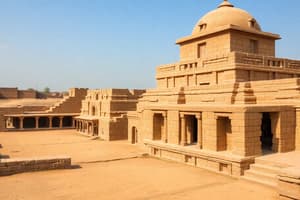Podcast
Questions and Answers
Which animal was not commonly depicted in the art of the Indus Valley civilization?
Which animal was not commonly depicted in the art of the Indus Valley civilization?
- Lion (correct)
- Bull
- Tiger
- Elephant
What type of script was used in the writing of the Indus Valley civilization?
What type of script was used in the writing of the Indus Valley civilization?
- Alphabetic script
- Hieroglyphic script
- Pictographic script (correct)
- Cuneiform script
What was the primary crop cultivated by the Indus Valley civilization?
What was the primary crop cultivated by the Indus Valley civilization?
- Barley (correct)
- Wheat
- Rice
- Maize
What was the purpose of the Great Bath in the Indus Valley civilization?
What was the purpose of the Great Bath in the Indus Valley civilization?
What evidence suggests that the Indus Valley civilization had a well-organized system of governance?
What evidence suggests that the Indus Valley civilization had a well-organized system of governance?
What was a significant aspect of the urban planning in the Indus Valley civilization?
What was a significant aspect of the urban planning in the Indus Valley civilization?
Which Central Asian conqueror's devastating raid on Delhi triggered a major political transformation in Northern India?
Which Central Asian conqueror's devastating raid on Delhi triggered a major political transformation in Northern India?
Who invaded northern India in 1526 and conquered the Sultanate, leading to its succession by the Mughal Empire?
Who invaded northern India in 1526 and conquered the Sultanate, leading to its succession by the Mughal Empire?
What was the name of the female ruler who reigned from 1236 to 1240 during the Delhi Sultanate?
What was the name of the female ruler who reigned from 1236 to 1240 during the Delhi Sultanate?
What was the established language that developed during the Sultanate and had a concrete impact on Indo-Islamic architecture?
What was the established language that developed during the Sultanate and had a concrete impact on Indo-Islamic architecture?
Which event set the scene for centuries of migration of fleeing soldiers, intelligentsia, mystics, traders, artists, and artisans from West and Central Asia into the subcontinent, thereby establishing Islamic culture there?
Which event set the scene for centuries of migration of fleeing soldiers, intelligentsia, mystics, traders, artists, and artisans from West and Central Asia into the subcontinent, thereby establishing Islamic culture there?
Who laid the foundation of the Delhi Sultanate?
Who laid the foundation of the Delhi Sultanate?
Which dynasty ruled over the Delhi Sultanate after the Khalji dynasty?
Which dynasty ruled over the Delhi Sultanate after the Khalji dynasty?
What was the primary geographical area covered by the Delhi Sultanate?
What was the primary geographical area covered by the Delhi Sultanate?
Which empire did the Delhi Sultanate succeed?
Which empire did the Delhi Sultanate succeed?
Who led a new wave of rapid and ceaseless Muslim conquests deep into South India during the Khalji and Tughlaq rule?
Who led a new wave of rapid and ceaseless Muslim conquests deep into South India during the Khalji and Tughlaq rule?
Flashcards are hidden until you start studying
Study Notes
Indus Valley Civilization
- Animals rarely depicted include cats and elephants.
- The civilization utilized a script that remains undeciphered, commonly referred to as the Indus script.
- Primary crop cultivated was wheat, along with barley and possibly rice.
- The Great Bath served as a significant ritual purification space, suggesting religious and social importance.
- Evidence of standardized weights and measures, along with planning of urban grids, indicates an organized governance system.
- Urban planning featured advanced drainage systems and grid layouts, highlighting sophistication in city design.
Delhi Sultanate and Conquests
- The raid by Timur (Tamerlane) in 1398 led to a major political transformation in Northern India.
- Babur, a descendant of Timur, invaded India in 1526 and defeated the Sultanate, establishing the Mughal Empire.
- Razia Sultana was the female ruler of the Delhi Sultanate, reigning from 1236 to 1240.
- Persian was the established language during the Sultanate, influencing Indo-Islamic architecture and culture.
- The invasion of Genghis Khan and the subsequent establishment of Islamic rule facilitated centuries of migration and cultural exchange into South Asia.
- Qutb al-Din Aibak laid the foundation of the Delhi Sultanate after the decline of the Ghurid Empire.
- The Tughlaq dynasty succeeded the Khilji dynasty in ruling the Delhi Sultanate.
- The geographical area covered by the Delhi Sultanate spanned much of Northern India.
- The Delhi Sultanate succeeded the earlier Ghurid Empire in the region.
- During the Khalji and Tughlaq rule, Alauddin Khalji led significant military campaigns deep into South India, expanding Muslim control.
Studying That Suits You
Use AI to generate personalized quizzes and flashcards to suit your learning preferences.




